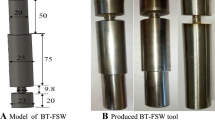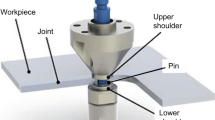Abstract
Friction stir welding (FSW) has attracted many attentions in both academic and industrial sectors due to its promising characteristics compared with other conventional joining techniques. However, it still needs some improvements to become reliable and cost-effective for industrial applications. In this study, the aim is to develop a right angle friction stir welding (RAFSW) technique to assemble large side panels of truck boxes so that the technique be industrially reliable and cost-effective. For this purpose, Taguchi method and artificial neural network (ANN) modeling were used to design the experiments and optimize the welding process parameters. The efficient working window of welding process parameters was obtained at traverse speeds as high as 1700 mm/min. Then, the technique was developed to operate in force control mode using a spring load tool holder and a newly designed tool with a tapered entry. It is shown that the developed technique could tolerate high levels of joint fit-up disturbances like big gaps between the sheets before welding. Moreover, it was demonstrated that the developed technique could be operated using large, low-cost, CNC machining routers and with clamping only at the corners of panels. The use of weld tags prior to welding was beneficial in order to reduce clamping and distortion while maintaining a high strength level along the joints. NX-NASTRAN Finite Element software and various experiments including static and fatigue tests of the panels were used to design and evaluate the welded assembly. It was found that the developed RAFSW technique has the potential to be used for truck panel assembly.














Similar content being viewed by others
References
Momeni M, Guillot M (2019) Effect of tool design and process parameters on lap joints made by right angle friction stir welding (RAFSW). Journal of Manufacturing and Materials Processing 3(3):66
Salari E, Jahazi M, Khodabandeh A, Ghasemi-Nanesa H (2014) Influence of tool geometry and rotational speed on mechanical properties and defect formation in friction stir lap welded 5456 aluminum alloy sheets. Mater Des 58:381–389
Mishra RS, Ma ZY (2005) Friction stir welding and processing. Materials Science & Engineering R 50(1):1–78
Mishra, R.S. and Mahoney, M.W. (2007) Future outlook for friction stir welding and processing. In friction stir welding and processing (Mishra, R.S. and Mahoney, M.W. eds), pp. 351-352, ASM International
Buffa G, Campanile G, Fratini L, Prisco A (2009) Friction stir welding of lap joints: influence of process parameters on the metallurgical and mechanical properties. Materials Science & Engineering A 519(1):19–26
Liu H, Zhao Y, Hu Y, Chen S, Lin Z (2015) Microstructural characteristics and mechanical properties of friction stir lap welding joint of Alclad 7B04-T74 aluminum alloy. Int J Adv Manuf Technol 78(9):1415–1425
D’Urso G, Giardini C (2010) The influence of process parameters and tool geometry on mechanical properties of friction stir welded aluminum lap joints. Int J Mater Form 3(1):1011–1014
Babu S, Ram GDJ, Venkitakrishnan PV, Reddy GM, Rao KP (2012) Microstructure and mechanical properties of friction stir lap welded aluminum alloy AA2014. Journal of Materials Science & Technology 28(5):414–426
Momeni M, Guillot M (2018) Development of friction stir welding technique at right angle (RAFSW) applied on butt joint of AA6061-T6 aluminum alloy. Int J Adv Manuf Technol 99(9):3077–3089
Imani, Y., Development of friction stir welding techniques for multi-axis machines, Mechanical Engineering, Laval University, Canada, Quebec, 2015
Okuyucu H, Kurt A, Arcaklioglu E (2007) Artificial neural network application to the friction stir welding of aluminum plates. Mater Des 28(1):78–84
Yadava MK, Mishra RS, Chen YL, Carlson B, Grant GJ (2010) Study of friction stir joining of thin aluminium sheets in lap joint configuration. Sci Technol Weld Join 15(1):70–75
Rai R, de A, Bhadeshia HKDH, DebRoy T (2011) Review: friction stir welding tools. Sci Technol Weld Join 16(4):325–342
Movahedi M, Kokabi AH, Reihani SMS, Najafi H (2012) Effect of tool travel and rotation speeds on weld zone defects and joint strength of aluminium steel lap joints made by friction stir welding. Sci Technol Weld Join 17(2):162–167
Wang M, Zhang H, Zhang J, Zhang X, Yang L (2014) Effect of pin length on hook size and joint properties in friction stir lap welding of 7B04 aluminum alloy. J Mater Eng Perform 23(5):1881–1886
Yazdanian S (2009) Effect of friction stir lap welding conditions on joint strength of aluminium alloy 6060. IOP Conference Series: Materials Science and Engineering 4(1):012021
Gibson BT, Lammlein DH, Prater TJ, Longhurst WR, Cox CD, Ballun MC, Dharmaraj KJ, Cook GE, Strauss AM (2014) Friction stir welding: process, automation, and control. J Manuf Process 16(1):56–73
Longhurst WR, Strauss AM, Cook GE, Cox CD, Hendricks CE, Gibson BT, Dawant YS (2010) Investigation of force-controlled friction stir welding for manufacturing and automation. Proc Inst Mech Eng B J Eng Manuf 224(6):937–949
Smith, C.B. (2007) Robots and machines for friction stir welding/processing. In Friction stir welding and processing (Mishra, R.S. and Mahoney, M.W. eds), pp. 219-233, ASM International
Cook GE et al (2003) Controlling robotic friction stir welding. Weld J 82(28):34
Zhang YN, Cao X, Larose S, Wanjara P (2012) Review of tools for friction stir welding and processing. Can Metall Q 51(3):250–261
Silva A et al (2015) Ultimate tensile strength optimization of different FSW aluminium alloy joints. Int J Adv Manuf Technol 79(5–8):805–814
Balakrishnan M, Leitão C, Arruti E, Aldanondo E, Rodrigues DM (2018) Influence of pin imperfections on the tensile and fatigue behaviour of AA 7075-T6 friction stir lap welds. Int J Adv Manuf Technol 97(5):3129–3139
Acknowledgments
The authors would like to thank the PI2/REGAL team members who made this research possible.
Funding
This research has been supported by funds of PI2 Team.
Author information
Authors and Affiliations
Corresponding author
Additional information
Publisher’s note
Springer Nature remains neutral with regard to jurisdictional claims in published maps and institutional affiliations.
Rights and permissions
About this article
Cite this article
Momeni, M., Guillot, M. Implementation of right angle friction stir welding (RAFSW) to assemble the side panels of truck box. Int J Adv Manuf Technol 110, 351–364 (2020). https://doi.org/10.1007/s00170-020-05764-2
Received:
Accepted:
Published:
Issue Date:
DOI: https://doi.org/10.1007/s00170-020-05764-2




